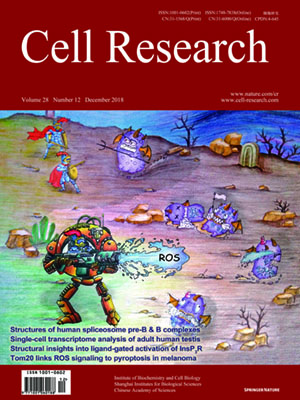
Volume 28, No 12, Dec 2018
ISSN: 1001-0602
EISSN: 1748-7838 2018
impact factor 17.848*
(Clarivate Analytics, 2019)
Volume 28 Issue 12, December 2018: 1195-1197
LETTERS TO THE EDITOR
Cryo-EM structure of Type III-A CRISPR effector complex
Yangao Huo 1,2, Tao Li 1,3, Nan Wang 1,3, Qinghua Dong 1, Xiangxi Wang 1 and Tao Jiang 1,3
1National Laboratory of Macromolecules, Institute of Biophysics,Chinese Academy of Sciences, Beijing, China; 2School of Life Science and Engineering, Foshan University, Guangdong, China and 3 University of Chinese Academy of Sciences, Beijing, China
Correspondence: These authors contributed equally: Yangao Huo, Tao Li, Nan WangCorrespondence: Yangao Huo (huoyangao@moon.ibp.ac.cn) orXiangxi Wang (xiangxi@ibp.ac.cn) or Tao Jiang (tjiang@ibp.ac.cn)
Dear Editor,
In bacteria and archaea, Clustered Regularly Interspaced Short Palindromic Repeats (CRISPR) and CRISPR-associated (Cas) proteins constitute a crRNA-guided surveillance complex that defends against invading nucleic elements.1 The CRISPR-Cas system can be divided into six types (Types I–VI), which differ in terms of their nucleic acid target, number and arrangement of cas genes, and the composition of a silencing complex. The Type III CRISPR-Cas system can be further classified into two main subtypes: Type III-A and Type III-B. The CRISPR-Cas effector complex of the Type III CRISPR-Cas system consists of five subunits (Csm1–5) in Type III-A (Fig. 1a) and six subunits (Cmr1–6) in Type III-B, both binding a crRNA composed of a typical repeat-derived 8-nucleotide (nt) 5′-handle followed by a long variable RNA-guide region. In contrast to Type I and II effectors that target dsDNA, Type III effectors are sequence-specific RNases that cleave target RNA and also target RNA-stimulated nonspecific DNases.2 To date, although atomic resolution structures of Type III-B effector complexes have been obtained,3,4 only low resolution electron microscopy (EM) structures of Csm effector complexes from different species have been reported, including S. solfataricus Csm complex (SsCsm),5 T. thermophilus Csm complex (TtCsm),6 and T. onnurineus complex (ToCsm).7 These structures reveal the overall architectural features of the Csm complex, however, the precise mechanisms of the Type III-A complex assembly and action remain elusive because of the lack of the atomic resolution structure. Recently, Type III effector complexes were demonstrated to synthesize a novel second messenger, cyclic oligonucleotide (tetra-adenylate/hexa-adenylate, cOA4/cOA6), for activating the nonspecific RNA degradation activity of Csm6/Csx1.8,9 The molecule synthesized by Csm1 requires the binding of noncomplementary target RNA to the Csm effector complex, but the mechanism involved in this process is still unclear. Moreover, for the Type III effector complex, it remains unclear how the 3′-flanking sequence of target RNA controls the ssDNA cleavage.10 To obtain a better understanding of the assembly and molecular mechanisms of the Type III-A complex, we purified the Csm effector complex of T. onnurineus (ToCsm effector complex) expressed in E. coli, performed single particle Cryo-EM studies and solved its structure at a resolution of 3.35 Å (Supplementary information, Figs. S1–S3 and Table S1).
https://doi.org/10.1038/s41422-018-0115-6
FULL TEXT | PDF
Browse 1446


